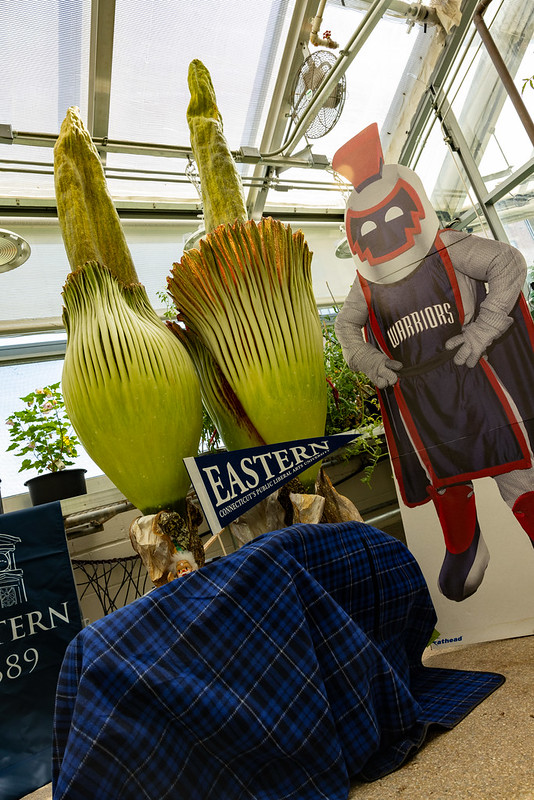- Apply
- Visit
- Request Info
- Give



Published on June 06, 2024

Similar to how the elusive corpse flower’s powerful stench attracts insects from far away, a rare twin corpse flower at Eastern attracted humans from across the country to the University’s greenhouse this June.
The unusual and highly anticipated two-stemmed amorphophallus titanium, popularly known as "corpse flower,” double-bloomed the evening of June 4 in the David G. Carter Science Building. The short-lived occurrence—corpse flowers only stay in bloom for up to 72 hours—brought with it a swarm of plant enthusiasts and media coverage.
Corpse flowers are notorious for the noxious odor they give off to attract pollinators that normally live around dead animals, and also for their immense size and shape. The fact that blooms only last a couple days before dying away for years at a time adds to the allure.
More than 300 visitors made their way to campus over two days during the greenhouse’s public viewing hours. People came from across the state and as far away as Boston, New Jersey and even Texas. Among the “anthophiles” was a little girl whose favorite plant is the corpse flower; a couple who love the plant so much that they have it tattooed on their body; a local family who took a Christmas photo with the corpse flower; classrooms of preschool children; and many other curious characters.
Thousands more tuned into the University’s live stream on Youtube. TV outlets, radio broadcasters and news reporters were also among the spectators, eager to glimpse the peculiar plant for its ephemeral, semiannual bloom.
The visitor from furthest away was Manny Aybar from Dallas, TX, who flew across the country specifically to witness the double bloom. “People study these flowers their whole life and never see a double bloom,” said Aybar, whose plant background includes being a judge for the American Orchid Society.
“To be able to see a double bloom is a lifetime opportunity. The fact that we have one in the United States, in a small university in the middle of Connecticut, is amazing.”
The corpse flower is native to the Indonesian island of Sumatra. It is the world's largest unbranched inflorescence—a group of flowers arranged on a stem—reaching heights up to 12 feet tall. A corpse flower's first bloom may take up to 10 years and last just three days. Subsequent blooms may occur every second or third year.
Rare as they are, a double-stemmed flower is even more uncommon, with only several documented in recent history, according to the United States Botanic Garden. Botanist and Professor of Biology Bryan Connolly thinks the double-stemmed corpse flower may be due to a greenhouse mishap from several years ago.
He and some students mistakenly cracked the plant’s “corm” with a shovel— the underground organ responsible for storing energy between blooms—when attempting to transplant it into a larger pot while it was dormant. “I got pretty upset, I thought we killed it,” said Connolly, “but we removed the old soil, put in new soil and hoped it wouldn’t rot.”
A few months later a giant leaf unusually grew out the side of the corm—usually they stem from the center. “Something was different (with the plant) after the injury,” he noted.
Eastern’s greenhouse contains two genetic individuals and several clones of corpse flower. The plants are self-incompatible, therefore require other blooming individuals to reproduce. According to Connolly, greenhouse corpse flowers are rarely in bloom at the same time. To facilitate pollination, botanical gardens often send pollen to each other to produce seed.
Connolly says the plant reeks of feces and rotting fish to attract pollinators that normally feed and lay eggs on dead animals. Because they are rare in the wild with only approximately 1,000 individuals in their native habitat—the species is classified as endangered by the International Union for the Conservation of Nature—the flowers' powerful odor is necessary to facilitate cross-pollination between plants that may be miles apart.
Written by Michael Rouleau